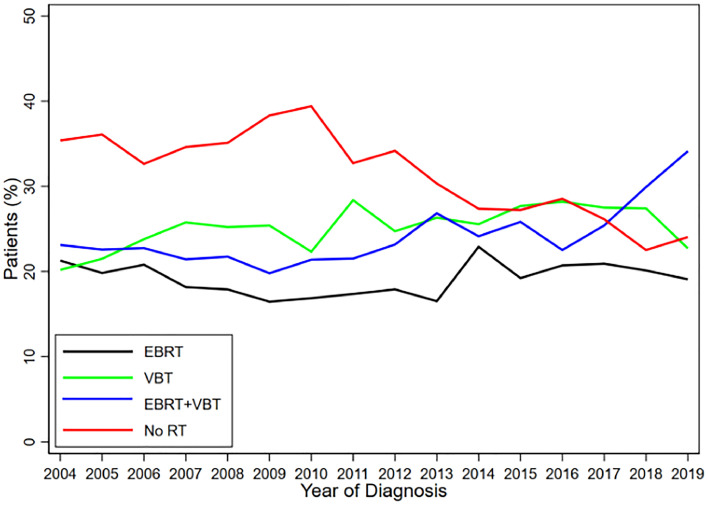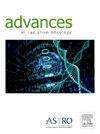Patterns of Care in Adjuvant Radiation Therapy for Stage II Endometrioid Endometrial Adenocarcinoma: A National Cancer Database Analysis
IF 2.7
Q3 ONCOLOGY
引用次数: 0
Abstract
Purpose
Treating stage II endometrial cancer involves total hysterectomy, bilateral salpingo-oophorectomy, and risk-adapted adjuvant therapy. Professional guidelines support various adjuvant treatments, but high-level data supporting specific options are conflicting. We sought to evaluate adjuvant radiation therapy (RT) trends for these patients, hypothesizing increased utilization of pelvic external beam RT (EBRT) over time.
Methods and Materials
Patients diagnosed in 2004-2019 with stage II endometrioid endometrial cancer who underwent total hysterectomy, bilateral salpingo-oophorectomy, and surgical staging were identified in the National Cancer Database. Patient characteristics per adjuvant RT received were compared using Wilcoxon rank sum and analysis of variance testing. Multivariable regression analysis (MVA) identified variables associated with EBRT, vaginal brachytherapy (VBT), or RT omission. A P value < .05 was significant, except in MVA, where Bonferroni correction was employed (p value < .017).
Results
Patients meeting criteria totaled 18,798; 19% received adjuvant EBRT alone, 25% VBT alone, 24% EBRT + VBT, and 32% no RT. Adjuvant RT use increased from 2004 to 2019, particularly EBRT + VBT (p < .05). In MVA, community hospital treatment (odds ratio [OR], 1.8; p < .001), Midwest location (OR, 1.2; p = .02), single-agent chemotherapy receipt (OR, 6.9; p < .001), lymphovascular space invasion (OR, 1.4; p < .001), and positive surgical margins (OR, 1.8; p < .001) were positively associated with EBRT. No variables were positively associated with VBT. Black race (OR, 1.2; p = .03), community hospital treatment (OR, 1.4; p = .04), South (OR, 2.2; p < .001) or West (OR, 2.1; p < .001) location, distance >50 miles from the treatment center (OR, 1.5; p < .001), and grade 2 (OR, 1.2; p < .001) or 3 (OR, 1.3; p = .01) disease were associated with RT omission.
Conclusions
Adjuvant RT for stage II endometrial cancer increased over time, particularly EBRT + VBT. Patient-related factors such as race, region, and distance from the treatment center were associated with RT omission, suggesting sociodemographic barriers to care. Tumor-related factors such as positive surgical margins and lymphovascular space invasion were associated with EBRT receipt, suggesting consideration of high-risk factors for locoregional recurrence in adjuvant RT approaches.

辅助放射治疗II期子宫内膜样子宫内膜腺癌的护理模式:国家癌症数据库分析。
目的:II期子宫内膜癌的治疗包括全子宫切除术、双侧输卵管-卵巢切除术和风险适应辅助治疗。专业指南支持各种辅助治疗,但支持具体选择的高级数据相互矛盾。我们试图评估这些患者的辅助放射治疗(RT)趋势,假设盆腔外束放射治疗(EBRT)的使用随着时间的推移而增加。方法和材料:在国家癌症数据库中确定2004-2019年诊断为II期子宫内膜样子宫内膜癌并接受全子宫切除术、双侧输卵管-卵巢切除术和手术分期的患者。采用Wilcoxon秩和和方差分析对接受辅助放疗的患者特征进行比较。多变量回归分析(MVA)确定了与EBRT、阴道近距离治疗(VBT)或RT遗漏相关的变量。除MVA采用Bonferroni校正外,P值< 0.05显著(P值< 0.017)。结果:符合标准的患者共18798例;19%的人单独接受了EBRT辅助治疗,25%的人单独接受了VBT辅助治疗,24%的人接受了EBRT + VBT辅助治疗,32%的人没有接受RT辅助治疗。从2004年到2019年,辅助RT的使用增加了,特别是EBRT + VBT (p < 0.05)。在MVA中,社区医院治疗(优势比[OR], 1.8;p < .001),中西部地区(OR, 1.2;p = .02),单药化疗剂量(OR, 6.9;p < 0.001),淋巴血管间隙侵犯(OR, 1.4;p < 0.001),手术切缘阳性(OR, 1.8;p < 0.001)与EBRT呈正相关。没有变量与VBT呈正相关。黑人种族(OR, 1.2;p = .03),社区医院治疗(OR, 1.4;p = .04),南方(OR, 2.2;p < 0.001)或West (or, 2.1;p < .001)位置,距离治疗中心50英里(OR, 1.5;p < .001), 2级(OR, 1.2;p < .001)或3 (or, 1.3;p = 0.01)疾病与RT遗漏相关。结论:II期子宫内膜癌的辅助放疗随着时间的推移而增加,尤其是EBRT + VBT。患者相关因素,如种族、地区和距离治疗中心的距离与RT遗漏有关,提示护理的社会人口学障碍。肿瘤相关因素,如手术切缘阳性和淋巴血管间隙浸润与EBRT接受相关,提示在辅助RT入路中考虑局部复发的高危因素。
本文章由计算机程序翻译,如有差异,请以英文原文为准。
求助全文
约1分钟内获得全文
求助全文
来源期刊

Advances in Radiation Oncology
Medicine-Radiology, Nuclear Medicine and Imaging
CiteScore
4.60
自引率
4.30%
发文量
208
审稿时长
98 days
期刊介绍:
The purpose of Advances is to provide information for clinicians who use radiation therapy by publishing: Clinical trial reports and reanalyses. Basic science original reports. Manuscripts examining health services research, comparative and cost effectiveness research, and systematic reviews. Case reports documenting unusual problems and solutions. High quality multi and single institutional series, as well as other novel retrospective hypothesis generating series. Timely critical reviews on important topics in radiation oncology, such as side effects. Articles reporting the natural history of disease and patterns of failure, particularly as they relate to treatment volume delineation. Articles on safety and quality in radiation therapy. Essays on clinical experience. Articles on practice transformation in radiation oncology, in particular: Aspects of health policy that may impact the future practice of radiation oncology. How information technology, such as data analytics and systems innovations, will change radiation oncology practice. Articles on imaging as they relate to radiation therapy treatment.
 求助内容:
求助内容: 应助结果提醒方式:
应助结果提醒方式:


